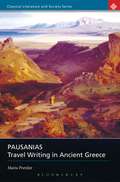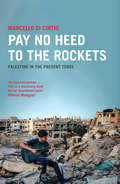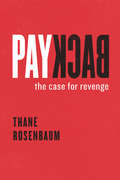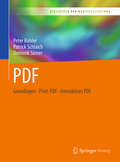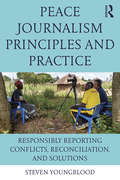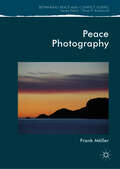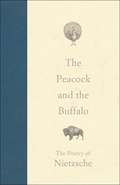- Table View
- List View
Paul Nizan: Committed Literature in a Conspiratorial World
by W. RedfernSartre's friend and sometime rival, Paul Nizan was a prototype of the angry young man. Ideologically a Marxist, politically a Communist, professionally a writer, endowed—Sartre conceded—with a sharper mind and greater literary ability than his own, Nizan diagnosed the ills of French society in the 1930's. His writings, vilified by the Party he left in September 1939, are being rediscovered in France. W. D. Redfern gives now the first full-length appraisal in English of his life and work.Nizan as a writer and a critical intelligence is seen in Mr. Redfern's analysis of his radical imagination and its deployment in his novels, polemical essays, journalism, and correspondence. His place among his contemporaries is also assessed, Mr. Redfern thus illuminating the political and literary worlds of the philosophical rebels (Berl, Politzer, Friedmann), the Communists and idealists (Aragon, Malraux, Weil) in Paris during the 1920"s and 1930's.Originally published in 1972.The Princeton Legacy Library uses the latest print-on-demand technology to again make available previously out-of-print books from the distinguished backlist of Princeton University Press. These editions preserve the original texts of these important books while presenting them in durable paperback and hardcover editions. The goal of the Princeton Legacy Library is to vastly increase access to the rich scholarly heritage found in the thousands of books published by Princeton University Press since its founding in 1905.
Paul Valery: An Anthology
by Paul Valéry James R. LawlerJames R. Lawler's elegant introduction deals with Valéry's concerns and his influence, and also with critical interpretations of his work. The volume begins with "The Evening with Monsieur Teste" (1896), from the famous "anti-novel" Monsieur Teste, for whose translation Jackson Mathews received the National Book Award in 1974. It includes such notable essays as the "Introduction to the Method of Leonardo da Vinci," "The Crisis of Mind," and "Poetry and Abstract Thought." The importance of Valéry's prose poetry has only recently been recognized, and a selection is presented here. There are also ten of his best-known poems in verse, among them "La Jeune Parque" and "Le Cimetiere Marin," with the French texts facing the English translations by David Paul. The anthology closes with two dialogues, one dating from the twenties, the other from 1943; which demonstrate the play of ideas--the intellectual vigor and grace--that are characteristic of Valéry's work as a whole.
Pauline Style and Renaissance Literary Culture
by Daniel KnapperAs a major source of debate on theological topics such as the resurrection of body and soul, justification by faith, and predestination, the New Testament epistles of Saint Paul played a central role in the development of religious thought and practice across Reformation Europe. But in a period when Christian belief and Biblical knowledge permeated every aspect of human life, how did Paul's epistles inform Europe's literary and rhetorical cultures? How did scholars and artists respond, not just to Paul's provocative ideas, but also to his provocative manner of expressing them? Pauline Style and Renaissance Literary Culture is the first critical history of Saint Paul's rhetorical style in the Renaissance, 1500-1700. It explores critical and creative responses to Paul's style across a wide range of mediums and genres, at a time when two powerful and confluent cultural forces—Humanism and Protestantism—profoundly altered conceptions of Biblical writing. Daniel Knapper argues that Paul's style developed into one of the most theoretically productive and artistically provocative styles of the Renaissance primarily because of its controversial reception among European Biblical humanists, who struggled to define and assess its volatile features, qualities, and expressive functions. This theoretical discourse directly impacted literary activity in England, shaping how and why English writers imitated Paul's style in their literary works. From the plays of William Shakespeare, to the devotional poetry of John Donne, to the courtly sermons of Lancelot Andrewes, to the polemical prose and epic poetry of John Milton, English writers imitated Paul's style—or, more precisely, a set of critically and culturally determined aspects of Paul's style—to produce specific aesthetic effects, reflect on pressing theological problems, and engage in heated religious controversies. In tracing the reception of Paul's style in Renaissance literary culture, this groundbreaking study reveals how and why English writers drew on Biblical models to develop their literary practices, even as it reveals how issues of style and rhetoric shaped Biblical interpretation and theological discourse in the contentious religious crucible of Reformation Europe.
Pauline Style and Renaissance Literary Culture
by Daniel KnapperAs a major source of debate on theological topics such as the resurrection of body and soul, justification by faith, and predestination, the New Testament epistles of Saint Paul played a central role in the development of religious thought and practice across Reformation Europe. But in a period when Christian belief and Biblical knowledge permeated every aspect of human life, how did Paul's epistles inform Europe's literary and rhetorical cultures? How did scholars and artists respond, not just to Paul's provocative ideas, but also to his provocative manner of expressing them? Pauline Style and Renaissance Literary Culture is the first critical history of Saint Paul's rhetorical style in the Renaissance, 1500-1700. It explores critical and creative responses to Paul's style across a wide range of mediums and genres, at a time when two powerful and confluent cultural forces—Humanism and Protestantism—profoundly altered conceptions of Biblical writing. Daniel Knapper argues that Paul's style developed into one of the most theoretically productive and artistically provocative styles of the Renaissance primarily because of its controversial reception among European Biblical humanists, who struggled to define and assess its volatile features, qualities, and expressive functions. This theoretical discourse directly impacted literary activity in England, shaping how and why English writers imitated Paul's style in their literary works. From the plays of William Shakespeare, to the devotional poetry of John Donne, to the courtly sermons of Lancelot Andrewes, to the polemical prose and epic poetry of John Milton, English writers imitated Paul's style—or, more precisely, a set of critically and culturally determined aspects of Paul's style—to produce specific aesthetic effects, reflect on pressing theological problems, and engage in heated religious controversies. In tracing the reception of Paul's style in Renaissance literary culture, this groundbreaking study reveals how and why English writers drew on Biblical models to develop their literary practices, even as it reveals how issues of style and rhetoric shaped Biblical interpretation and theological discourse in the contentious religious crucible of Reformation Europe.
Pausanias: Travel Writing in Ancient Greece (Classical Literature and Society)
by Maria PretzlerIn this book, Maria Pretzler combines a thorough introduction to Pausanias with exciting new perspectives. She considers the process and influences that shaped the "Periegesis", and maps out its literary and cultural context. Pausanias' text records contemporary interpretations of monuments and traditions, and is concerned with the identity and history of Greece, issues that were crucial concerns for Greeks under Roman rule. Parallels with various texts of the period offer insights into Pausanias' attitudes as well as illustrating important aspects of Second Sophistic culture. A discussion of Greek texts that deal with fictional or actual travel experiences provides a background for a detailed study of the Periegesis as travel literature. Pausanias' treatment of geography and his descriptions of landscapes, cities and artworks are considered in detail, and there is also a study of his methods as a historian. The final chapters deal with Pausanias' impact on modern approaches to Greece and ancient Greek culture.
Pausanias: Travel Writing in Ancient Greece (Classical Literature and Society)
by Maria PretzlerIn this book, Maria Pretzler combines a thorough introduction to Pausanias with exciting new perspectives. She considers the process and influences that shaped the "Periegesis", and maps out its literary and cultural context. Pausanias' text records contemporary interpretations of monuments and traditions, and is concerned with the identity and history of Greece, issues that were crucial concerns for Greeks under Roman rule. Parallels with various texts of the period offer insights into Pausanias' attitudes as well as illustrating important aspects of Second Sophistic culture. A discussion of Greek texts that deal with fictional or actual travel experiences provides a background for a detailed study of the Periegesis as travel literature. Pausanias' treatment of geography and his descriptions of landscapes, cities and artworks are considered in detail, and there is also a study of his methods as a historian. The final chapters deal with Pausanias' impact on modern approaches to Greece and ancient Greek culture.
Pause and Effect: An Introduction to the History of Punctuation in the West
by M.B. ParkesFrom its publication in 1992 Pause and Effect has become a cornerstone of the study of punctuation across the world. Described as 'magisterial' by Lynne Truss in her best-selling Eats, Shoots and Leaves, this book has stimulated interest and scholarly debates among writers, literary critics, philosophers, linguists, rhetoricians, palaeographers and all those who study the use of language. To celebrate this extraordinary achievement, Pause and Effect has been republished in September 2008, coinciding with the publication of the author's new work, Their Hands Before Our Eyes. The first part of Pause and Effect identifies the graphic symbols of punctuation and deals with their history. It covers the antecedents of the repertory of symbols, as well as the ways in which the repertory was refined and augmented with new symbols to meet changing requirements. The second part offers a short general account of the principal influences which have contributed to the ways in which the symbols have been applied in texts, focusing on the evidence of the practice itself rather than on theorists. The treatment enables the reader to compare usages in different periods, and to isolate the principles which underlie the use of punctuation in all periods. The examples and plates which are at the core of the book provide the reader with an opportunity to test the author's observations. The examples are taken from a wide range of literary texts from different periods and languages. Latin texts are accompanied by English translation intended to illustrate the use of punctuation in the originals in so far as this is possible.
Pause and Effect: An Introduction to the History of Punctuation in the West
by M.B. ParkesFrom its publication in 1992 Pause and Effect has become a cornerstone of the study of punctuation across the world. Described as 'magisterial' by Lynne Truss in her best-selling Eats, Shoots and Leaves, this book has stimulated interest and scholarly debates among writers, literary critics, philosophers, linguists, rhetoricians, palaeographers and all those who study the use of language. To celebrate this extraordinary achievement, Pause and Effect has been republished in September 2008, coinciding with the publication of the author's new work, Their Hands Before Our Eyes. The first part of Pause and Effect identifies the graphic symbols of punctuation and deals with their history. It covers the antecedents of the repertory of symbols, as well as the ways in which the repertory was refined and augmented with new symbols to meet changing requirements. The second part offers a short general account of the principal influences which have contributed to the ways in which the symbols have been applied in texts, focusing on the evidence of the practice itself rather than on theorists. The treatment enables the reader to compare usages in different periods, and to isolate the principles which underlie the use of punctuation in all periods. The examples and plates which are at the core of the book provide the reader with an opportunity to test the author's observations. The examples are taken from a wide range of literary texts from different periods and languages. Latin texts are accompanied by English translation intended to illustrate the use of punctuation in the originals in so far as this is possible.
Pay No Heed to the Rockets: Palestine in the Present Tense
by Marcello Di CintioAcross Palestine, from the Allenby Bridge and Ramallah, to Jerusalem and Gaza, Marcello Di Cintio has met with writers, poets, librarians, booksellers and readers, finding extraordinary stories in every corner. Stories of how revolutionary writing was smuggled from the Naqab Prison; lost stories surrounding the looted books that sit in Israel’s National Library; and stories from the Gallery Café, whose opening three thousand creative intellectuals gathered to celebrate. Pay No Heed to the Rockets offers a window into the literary heritage of Palestine, revealing a humanity often unreported. Paying homage to the memory of giants like Mahmoud Darwish and Ghassan Kanafani and the contemporary authors whom they continue to inspire, this evocative, lyrical journey shares both the anguish and inspiration of Palestinian writers at work today.
Payback: The Case for Revenge
by Thane RosenbaumWe call it justice—the assassination of Osama bin Laden, the incarceration of corrupt politicians or financiers like Rod Blagojevich and Bernard Madoff, and the climactic slaying of cinema-screen villains by superheroes. But could we not also call it revenge? We are told that revenge is uncivilized and immoral, an impulse that individuals and societies should actively repress and replace with the order and codes of courtroom justice. What, if anything, distinguishes punishment at the hands of the government from a victim’s individual desire for retribution? Are vengeance and justice really so very different? No, answers legal scholar and novelist Thane Rosenbaum in Payback: The Case for Revenge—revenge is, in fact, indistinguishable from justice. Revenge, Rosenbaum argues, is not the problem. It is, in fact, a perfectly healthy emotion. Instead, the problem is the inadequacy of lawful outlets through which to express it. He mounts a case for legal systems to punish the guilty commensurate with their crimes as part of a societal moral duty to satisfy the needs of victims to feel avenged. Indeed, the legal system would better serve the public if it gave victims the sense that vengeance was being done on their behalf. Drawing on a wide range of support, from recent studies in behavioral psychology and neuroeconomics, to stories of vengeance and justice denied, to revenge practices from around the world, to the way in which revenge tales have permeated popular culture—including Hamlet, The Godfather, and Braveheart—Rosenbaum demonstrates that vengeance needs to be more openly and honestly discussed and lawfully practiced. Fiercely argued and highly engaging, Payback is a provocative and eye-opening cultural tour of revenge and its rewards—from Shakespeare to The Sopranos. It liberates revenge from its social stigma and proves that vengeance is indeed ours, a perfectly human and acceptable response to moral injury. Rosenbaum deftly persuades us to reconsider a misunderstood subject and, along the way, reinvigorates the debate on the shape of justice in the modern world.
Payback: The Case for Revenge
by Thane RosenbaumWe call it justice—the assassination of Osama bin Laden, the incarceration of corrupt politicians or financiers like Rod Blagojevich and Bernard Madoff, and the climactic slaying of cinema-screen villains by superheroes. But could we not also call it revenge? We are told that revenge is uncivilized and immoral, an impulse that individuals and societies should actively repress and replace with the order and codes of courtroom justice. What, if anything, distinguishes punishment at the hands of the government from a victim’s individual desire for retribution? Are vengeance and justice really so very different? No, answers legal scholar and novelist Thane Rosenbaum in Payback: The Case for Revenge—revenge is, in fact, indistinguishable from justice. Revenge, Rosenbaum argues, is not the problem. It is, in fact, a perfectly healthy emotion. Instead, the problem is the inadequacy of lawful outlets through which to express it. He mounts a case for legal systems to punish the guilty commensurate with their crimes as part of a societal moral duty to satisfy the needs of victims to feel avenged. Indeed, the legal system would better serve the public if it gave victims the sense that vengeance was being done on their behalf. Drawing on a wide range of support, from recent studies in behavioral psychology and neuroeconomics, to stories of vengeance and justice denied, to revenge practices from around the world, to the way in which revenge tales have permeated popular culture—including Hamlet, The Godfather, and Braveheart—Rosenbaum demonstrates that vengeance needs to be more openly and honestly discussed and lawfully practiced. Fiercely argued and highly engaging, Payback is a provocative and eye-opening cultural tour of revenge and its rewards—from Shakespeare to The Sopranos. It liberates revenge from its social stigma and proves that vengeance is indeed ours, a perfectly human and acceptable response to moral injury. Rosenbaum deftly persuades us to reconsider a misunderstood subject and, along the way, reinvigorates the debate on the shape of justice in the modern world.
Payback: The Case for Revenge
by Thane RosenbaumWe call it justice—the assassination of Osama bin Laden, the incarceration of corrupt politicians or financiers like Rod Blagojevich and Bernard Madoff, and the climactic slaying of cinema-screen villains by superheroes. But could we not also call it revenge? We are told that revenge is uncivilized and immoral, an impulse that individuals and societies should actively repress and replace with the order and codes of courtroom justice. What, if anything, distinguishes punishment at the hands of the government from a victim’s individual desire for retribution? Are vengeance and justice really so very different? No, answers legal scholar and novelist Thane Rosenbaum in Payback: The Case for Revenge—revenge is, in fact, indistinguishable from justice. Revenge, Rosenbaum argues, is not the problem. It is, in fact, a perfectly healthy emotion. Instead, the problem is the inadequacy of lawful outlets through which to express it. He mounts a case for legal systems to punish the guilty commensurate with their crimes as part of a societal moral duty to satisfy the needs of victims to feel avenged. Indeed, the legal system would better serve the public if it gave victims the sense that vengeance was being done on their behalf. Drawing on a wide range of support, from recent studies in behavioral psychology and neuroeconomics, to stories of vengeance and justice denied, to revenge practices from around the world, to the way in which revenge tales have permeated popular culture—including Hamlet, The Godfather, and Braveheart—Rosenbaum demonstrates that vengeance needs to be more openly and honestly discussed and lawfully practiced. Fiercely argued and highly engaging, Payback is a provocative and eye-opening cultural tour of revenge and its rewards—from Shakespeare to The Sopranos. It liberates revenge from its social stigma and proves that vengeance is indeed ours, a perfectly human and acceptable response to moral injury. Rosenbaum deftly persuades us to reconsider a misunderstood subject and, along the way, reinvigorates the debate on the shape of justice in the modern world.
Payback: The Case for Revenge
by Thane RosenbaumWe call it justice—the assassination of Osama bin Laden, the incarceration of corrupt politicians or financiers like Rod Blagojevich and Bernard Madoff, and the climactic slaying of cinema-screen villains by superheroes. But could we not also call it revenge? We are told that revenge is uncivilized and immoral, an impulse that individuals and societies should actively repress and replace with the order and codes of courtroom justice. What, if anything, distinguishes punishment at the hands of the government from a victim’s individual desire for retribution? Are vengeance and justice really so very different? No, answers legal scholar and novelist Thane Rosenbaum in Payback: The Case for Revenge—revenge is, in fact, indistinguishable from justice. Revenge, Rosenbaum argues, is not the problem. It is, in fact, a perfectly healthy emotion. Instead, the problem is the inadequacy of lawful outlets through which to express it. He mounts a case for legal systems to punish the guilty commensurate with their crimes as part of a societal moral duty to satisfy the needs of victims to feel avenged. Indeed, the legal system would better serve the public if it gave victims the sense that vengeance was being done on their behalf. Drawing on a wide range of support, from recent studies in behavioral psychology and neuroeconomics, to stories of vengeance and justice denied, to revenge practices from around the world, to the way in which revenge tales have permeated popular culture—including Hamlet, The Godfather, and Braveheart—Rosenbaum demonstrates that vengeance needs to be more openly and honestly discussed and lawfully practiced. Fiercely argued and highly engaging, Payback is a provocative and eye-opening cultural tour of revenge and its rewards—from Shakespeare to The Sopranos. It liberates revenge from its social stigma and proves that vengeance is indeed ours, a perfectly human and acceptable response to moral injury. Rosenbaum deftly persuades us to reconsider a misunderstood subject and, along the way, reinvigorates the debate on the shape of justice in the modern world.
PDF: Grundlagen – Print-PDF – Interaktives PDF (Bibliothek der Mediengestaltung)
by Peter Bühler Patrick Schlaich Dominik SinnerDieser Band der „Bibliothek der Mediengestaltung“ behandelt die Erstellung und Bearbeitung professioneller PDF-Dateien im Print-Workflow der Druckvorstufe und als interaktives digitales Medium.Für diese Bibliothek wurden die Themen des Kompendiums der Mediengestaltung neu strukturiert, vollständig überarbeitet und in ein handliches Format gebracht. Leitlinien waren hierbei die Anpassung an die Entwicklungen in der Werbe- und Medienbranche sowie die Berücksichtigung der aktuellen Rahmenpläne und Studienordnungen sowie Prüfungsanforderungen der Ausbildungs- und Studiengänge.Die Bände der „Bibliothek der Mediengestaltung“ enthalten zahlreiche praxisorientierte Aufgaben mit Musterlösungen und eignen sich als Lehr- und Arbeitsbücher an Schulen sowie Hochschulen und zum Selbststudium.
Peace in the US Republic of Letters, 1840-1900 (Oxford Studies in American Literary History)
by Prof Sandra M. GustafsonPeace in the US Republic of Letters, 1840-1900 explores the early peace movement as it captured the imagination of leading writers. The book charts the rise of the peace cause from its sources in the works of William Penn and John Woolman, through the founding of the first peace societies in 1815 and the mid-century peace congresses, to the postbellum movement's consequential emphasis on arbitration. The Civil War is the central axis for the book, with three chapters organized around readings of novels by James Fenimore Cooper, Harriet Beecher Stowe, and Nathaniel Hawthorne spanning the period from 1840 to 1865. Cooper had personal connections to the movement and thought deeply about the issues it addressed. Literary interest in peace at times overlapped with abolitionism, as was true for Stowe. And, in the case of Hawthorne, attention to peace advocacy arose out of a mixture of skepticism regarding perfectionist impulses, a desire to explore the nature and limits of violence, and fear of civil conflict. The volume also explores fiction engaged with problems that arose in the aftermath of that war, including novels by Henry Adams and John Hay on political corruption and class conflict; works on the failures of Reconstruction by Albion Tourgée and Charles Chesnutt; and the varied treatments of Indigenous experience in Helen Hunt Jackson's Ramona and Simon Pokagon's Queen of the Woods. All of these writers focused on issues related to the cause of peace, expanding its thematic reach and anticipating key insights of twentieth-century peace scholars.
Peace in the US Republic of Letters, 1840-1900 (Oxford Studies in American Literary History)
by Prof Sandra M. GustafsonPeace in the US Republic of Letters, 1840-1900 explores the early peace movement as it captured the imagination of leading writers. The book charts the rise of the peace cause from its sources in the works of William Penn and John Woolman, through the founding of the first peace societies in 1815 and the mid-century peace congresses, to the postbellum movement's consequential emphasis on arbitration. The Civil War is the central axis for the book, with three chapters organized around readings of novels by James Fenimore Cooper, Harriet Beecher Stowe, and Nathaniel Hawthorne spanning the period from 1840 to 1865. Cooper had personal connections to the movement and thought deeply about the issues it addressed. Literary interest in peace at times overlapped with abolitionism, as was true for Stowe. And, in the case of Hawthorne, attention to peace advocacy arose out of a mixture of skepticism regarding perfectionist impulses, a desire to explore the nature and limits of violence, and fear of civil conflict. The volume also explores fiction engaged with problems that arose in the aftermath of that war, including novels by Henry Adams and John Hay on political corruption and class conflict; works on the failures of Reconstruction by Albion Tourgée and Charles Chesnutt; and the varied treatments of Indigenous experience in Helen Hunt Jackson's Ramona and Simon Pokagon's Queen of the Woods. All of these writers focused on issues related to the cause of peace, expanding its thematic reach and anticipating key insights of twentieth-century peace scholars.
Peace Journalism Principles and Practices: Responsibly Reporting Conflicts, Reconciliation, and Solutions
by Steven YoungbloodLong-time peace journalist Steven Youngblood presents the foundations of peace journalism in this exciting new textbook, offering readers the methods, approaches, and concepts required to use journalism as a tool for peace, reconciliation, and development. Guidance is offered on framing stories, ethical treatment of sensitive subjects, and avoiding polarizing stereotypes through a range of international examples and case studies spanning from the Iraq war to the recent unrest in Ferguson, Missouri. Youngblood teaches students to interrogate traditional media narratives about crime, race, politics, immigration, and civil unrest, and to illustrate where—and how—a peace journalism approach can lead to more responsible and constructive coverage, and even assist in the peace process itself.
Peace Journalism Principles and Practices: Responsibly Reporting Conflicts, Reconciliation, and Solutions
by Steven YoungbloodLong-time peace journalist Steven Youngblood presents the foundations of peace journalism in this exciting new textbook, offering readers the methods, approaches, and concepts required to use journalism as a tool for peace, reconciliation, and development. Guidance is offered on framing stories, ethical treatment of sensitive subjects, and avoiding polarizing stereotypes through a range of international examples and case studies spanning from the Iraq war to the recent unrest in Ferguson, Missouri. Youngblood teaches students to interrogate traditional media narratives about crime, race, politics, immigration, and civil unrest, and to illustrate where—and how—a peace journalism approach can lead to more responsible and constructive coverage, and even assist in the peace process itself.
The Peace of Nicias and the Sicilian Expedition
by Donald KaganWhy did the Peace of Nicias fail to reconcile Athens and Sparta? Donald Kagan examines the years between the signing of the peace treaty and the destruction of the Athenian expedition to Sicily in 413 B.C. The principal figure in the narrative is the Athenian politician and general Nicias, whose policies shaped the treaty and whose military strategies played a major role in the attack against Sicily.
Peace Photography (Rethinking Peace and Conflict Studies)
by Frank MöllerThis study thinks with photography about peace. It asks how photography can represent peace, and how such representation can contribute to peace. The book offers an original critique of the almost exclusive focus on violence in recent work on visual culture and presents a completely new research agenda within the overall framework of visual peace research. Critically engaging with both photojournalism and art photography in light of peace theories, it looks for visual representations or anticipations of peace – peace or peace as a potentiality – in the work of selected photographers including Robert Capa and Richard Mosse, thus reinterpreting photography from the Spanish Civil War to current anti-migration politics in Europe. The book argues that peace photography is episodic, culturally specific, process-oriented and considerate of both the past and the future.
Peace, war and party politics: The Conservatives and Europe, 1846–59 (PDF)
by Geoffrey HicksPeace, war and party politics examines the mid-Victorian Conservative Party’s significant but overlooked role in British foreign policy and in contemporary debate about Britain’s relations with Europe. The book considers the Conservatives’ response - in opposition and government - to the tumultuous era of Napoleon III, the Crimean war and Italian unification. Within a clear chronological framework, it focuses on ‘high’ politics, and offers a detailed account of the party’s foreign policy in government under its longest-serving but forgotten leader, the fourteenth Earl of Derby. It attaches equal significance to domestic politics, and incorporates a provocative new analysis of Disraeli’s role in internal tussles over policy, illuminating the roots of the power struggle he would later win against Derby’s son in the 1870s. Overall, it helps to provide us with a fuller picture of mid-Victorian Britain’s engagement with the world. This book will be of use to those teaching and studying Victorian politics and foreign policy at all levels in higher education.
Peace, war and party politics: The Conservatives and Europe, 1846–59
by Geoffrey HicksPeace, war and party politics examines the mid-Victorian Conservative Party’s significant but overlooked role in British foreign policy and in contemporary debate about Britain’s relations with Europe. The book considers the Conservatives’ response – in opposition and government – to the tumultuous era of Napoleon III, the Crimean war and Italian unification. Within a clear chronological framework, it focuses on ‘high’ politics, and offers a detailed account of the party’s foreign policy in government under its longest-serving but forgotten leader, the fourteenth Earl of Derby. It attaches equal significance to domestic politics, and incorporates a provocative new analysis of Disraeli’s role in internal tussles over policy, illuminating the roots of the power struggle he would later win against Derby’s son in the 1870s. Overall, it helps to provide us with a fuller picture of mid-Victorian Britain’s engagement with the world. This book will be of use to those teaching and studying Victorian politics and foreign policy at all levels in higher education.
The Peacock and the Buffalo: The Poetry of Nietzsche
by Friedrich Nietzsche James LuchteThe Peacock and the Buffalo presents the first complete English translation of the poetry of the celebrated and hugely influential German thinker, Friedrich Nietzsche (1844-1900). From his first poems, written at the age of fourteen, to his last extant writings, this definitive bi-lingual edition includes all his 275 poems and aphorisms. Nietzsche's interest in poetry is no secret, as evidenced in his literary and philosophical masterpiece, Thus Spoke Zarathustra, not to mention the poetry included in his published philosophical works. This important collection shows that Nietzsche's commitment to poetry was in fact longstanding and integral to his articulation of the truth and lies of human existence. The Peacock and the Buffalo is a must-read for anyone with an interest in German literature or European philosophy.





